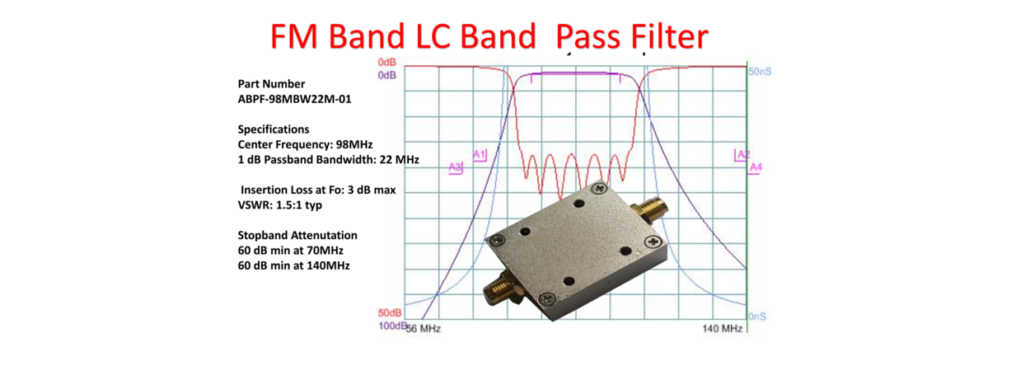FM-Band Bandpass Filter
FM-Band Bandpass Filter : LC filter for FM Receivers
AWG Tech makes FM-Band bandpass filter for use in our FM-Band pre-selector series of products and for some special applications FM receivers for our cusstomers.
FM-Band filters operate in the sprectral space from 87 – 108 MHz. We have FM-Band bandpass filters that passes the entire FM-band and FM-Band Bandpass Filter that occupies a small portion of the FM Band.

ABPF-98MBW22M-01 : An FM-Band LC Bandpass Filter
ABPF-98MBW22M-01 is an FM-Band bandpass filter that has a passband for the entire FM band. The 1 dB passband frequency is 87 – 109 MHz. The maximum passband insertion loss is 3 dB. In the stopband, the filter has a rejection of more than 60dBc at 70MHz and 140 MHz.
The table below shows some of the FM-Band bandpass filter that are in our standard catalogue.
| Part Number | Center Frequency | Passband Frequency | Insertion Loss at Center Frequency | Rejection |
|---|---|---|---|---|
| ABPF-98MBW22M-01 | 98 MHz | 87 – 107 MHz | 3 dB max | 40 dB @ dc-70MHz 40 dB @ 140-300MHz |
| ABPF-93MBW10M-01 | 93 MHz | 87 – 98 MHz | 2 dB max | 45 dB @ dc -70MHz 40 dB @ 120-300MHz |
| ABPF-103MBW10M-01 | 103 MHz | 98 – 108 MHz | 2 dB max | 40 dB @ dc – 88 MHz 40 dB @ 140 -130 MHz |
Contact Us Today!
AWG Tech has a wide variety of FM-Band LC Bandpass Filter with different passband frequencies and bandwidth.
Fill in the enquiry form below to request more information or to get an FM bandpass filter customized to your specifications.
Frequency Modulation: Historical Background and Basics
Frequency modulation (FM) is the widely utilized form of radio communications applications. FM broadcasts on the VHF bands continue to provide an extremely high audio quality, and FM is used for a wide array of forms of two way radio communications. It’s especially helpful for mobile radio communications, and is usually used in taxis and a lot of other vehicles as well.
In line of its widespread utilization as a FM-Band band pass filter or for other forms of communication systems, FM is also an essential form of modulation. Despite its numerous forms of digital transmission being utilized these days, FM frequencies continue to provide clearer signals for radio communication.
History of Frequency Modulation
FM has been utilized by many for a lot of years. However, its benefits were not immediately realized. In the early wireless days, it was considered that a narrower bandwidth was required to reduce noise and interferences. As FM failed to perform effectively under these conditions, AM then predominated and FM was never to be used. However, American engineer Edwin Armstrong looked at the use of wideband FM in broadcast communication and introduced the thought against the thinking trend of the time.
Ever since then, FM has grown enormously. Nowadays, wideband FM is still acknowledged as a form of very high quality transmission medium for high quality broadcasting. Plus, it’s also used for communication where it’s resilient to different signal strengths.
FM Concepts: The Need for Modulation
For a successful transmission and information reception, modulation is considered to be an essential process. Both audio and video signals can’t be sent directly from a broadcast station for a thousand miles, as these signals are both low on frequency and power. The signal strength diminishes as it propagates due to varying atmospheric effects. Other reasons for modulation include:
Mutual interference takes place if everyone starts sending low frequency signals
For a proper reception of signals, the size of the antenna should be of the wave length order of the signal ready to be received. Therefore, the lower the signal frequency the greater its wavelength will be and much larger antennas will be required and vice versa.
FM Frequency Features
The most noteworthy feature of frequency modulation is its resilience to varying signal levels. The modulation is carried only as variations in frequency. That is, any signal level variations won’t affect the audio output, provided that the signal doesn’t fall in a level that the receiver can’t cope up with.
FM waves possess a resilience property to noises and interferences. It’s for this reason that FM is utilized for high quality broadcast transmissions.
FM Transmission Applications
FM, as mentioned above, is usually utilized in VHF radio frequencies for high-fidelity broadcasts for both music and speech. Regular TV sound is also broadcasted through FM transmissions. The FM-Band band pass filter utilized in broadcast is typically called a wide-FM, or W-FM. In two-way radio, Narrowband-FM (N-FM) is used to conserve bandwidth. Adding up to the fray, it’s used to send signals into space.
